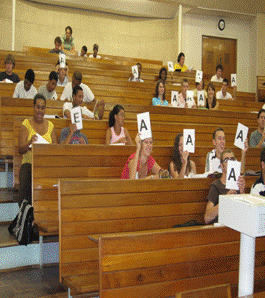|
||
| The New Struggle |
||
|
Delia Marshall Most academic staff at tertiary institutions has been confronted with the reality that the typical first-year student has changed dramatically over the past few years. The changing schooling system would probably be singled out as the main reason for students’ under-preparedness for higher education. “Stroll down the corridors of a typical college, and glance in some of the classrooms where freshman courses in physics are being taught. Chances are you will see something like the following. Instructors in front of the captive – but rarely captivated – audience are extolling, with various degrees of enthusiasm, the virtues of physics and solving the problems of the week. Seated obediently in uniform rows facing their leader are the students, vigorously scribbling in attempts to transcribe each utterance and every blackboard marking of the instructor. Eyes glaze as students try to avoid fading off.” [1] Is this a description of a typical first-year lecture at Stellenbosch University? Could this ‘traditional approach’ to teaching and learning contribute to the poor performance of our first-year students? Carl Wenning’s article [2] entitled ‘SAAMEE: A model for academic success’ prompted me to rethink my interaction with my first-year physics students, forcing me to carefully and critically think about HOW I teach. There has been extensive research done on students’ poor understanding of physics concepts following traditional teaching [3]. This has led to several research-based innovations in physics teaching and learning, with different objectives. Many of these innovations encourage more interactive engagement in lectures, to focus on deepening students’ conceptual understanding, or to take a more hands-on, inquiry-based approach to teaching. In 2006, I taught introductory physics to roughly 200 students who were majoring in biology. It is a service course offered in both Afrikaans and English, and therefore taught by different lecturers. I adopted two of the teaching innovations in my first-year physics teaching, and I will describe each one here.
The second innovation I tried out in my teaching was an emphasis on ‘concepts first’. Students have the tendency to go straight to the equation when answering a problem, without giving any thought to the underlying physics concept [4]. Interactive lecture demonstrations were used to force them to think about their own thinking as no equations are available to them. The pilot study that I undertook in 2006 aimed to probe whether a different teaching approach would alter the way students viewed and learned physics. Data were collected in the following ways: field notes made by an observer attending lectures; informal student evaluations (students were asked to comment on the usefulness of the ConcepTests, whether they thought the teaching innovations were useful, whether they had any suggestions for improving the interaction); informal and formal chats with students; and a focus group interview with approximately 15 or 20 students. Findings
Discussion The data indicated that the majority of students were very positive about the teaching innovations introduced into the introductory physics course, which aimed to encourage interactive engagement in lectures and a focus on conceptual understanding as a crucial first step in the process of problem solving. However, a significant proportion of the students did not experience these innovations as useful, since they were not perceived to be congruent with the assessment demands. The major systemic effect in this study seemed to be the non-congruence between the lecturer’s objectives and the perceived assessment demands. This study therefore highlights the need to ‘address the system as a whole’, as simply adding good components such as a new curriculum or teaching methods will not suffice. Students are accustomed to passive, transmission approaches to teaching at school and, in fact, this seems to be students’ predominant experience of lecturing in university classes too. In order to avoid that students feel challenged by new teaching approaches it is important that they are exposed to the same philosophy throughout their programme. References:
|
||
©
Copyright, Centre for Teaching and Learning, Stellenbosch University,
2007 |
